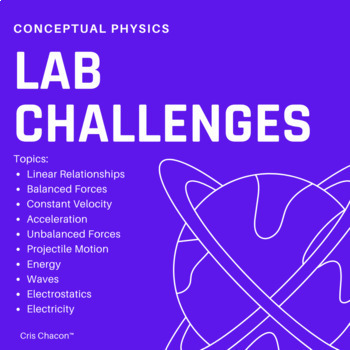01 - Density Bottle Lab Challenge
Conceptual Physics
172 Followers
Grade Levels
7th - 12th
Subjects
Resource Type
Standards
CCSS8.F.A.3
CCSS8.F.B.4
CCSS8.F.B.5
CCSSHSN-Q.A.1
CCSSHSN-Q.A.2
Formats Included
- Google Docs™
Pages
2 pages
Conceptual Physics
172 Followers

Made for Google Drive™
This resource can be used by students on Google Drive or Google Classroom. To access this resource, you’ll need to allow TPT to add it to your Google Drive. See our FAQ and Privacy Policy for more information.
Also included in
- 11 fully editable, NGSS/modeling pedagogy aligned summative lab challenges! Most lab challenges consist of 2 pages total, with space for students to provide the following information:Known variables and values Diagrams of any models utilized Calculations for any unknown valuesTools used and a briefPrice $60.00Original Price $79.00Save $19.00
- 21 fully editable, NGSS/modeling pedagogy aligned inquiry lab summaries & 11 lab challenges! Inquiry Labs:Most lab summaries consist of 2 pages total, with space for students to provide the following information:Lab investigation purposeData for the independent and dependent variableWritten statPrice $175.00Original Price $212.00Save $37.00
- 3 fully editable, NGSS/modeling pedagogy aligned worksheets, 4 inquiry labs, 3 lab challenges, 2 quizzes, 6 guided notes/reading assignments, 1 unit review, 1 writing assignment, 1 equation toolbox, and 1 curriculum guide!WorksheetsThere are a variety of free response questions for most worksheets,Price $60.00Original Price $76.00Save $16.00
- 17 fully editable, NGSS/modeling pedagogy aligned worksheets, 9 quizzes, 16 inquiry labs, 4 unit reviews, 4 unit tests, 7 lab challenges, 5 writing assignments, 5 concept builders, 5 equation toolboxes, 15 guided readings and notes, and 5 curriculum guides!WorksheetsThere are a variety of free respoPrice $350.00Original Price $427.00Save $77.00
Description
Fully editable, NGSS/modeling pedagogy aligned summative lab challenge! Most lab challenges consist of 2 pages total, with space for students to provide the following information:
- Known variables and values
- Diagrams of any models utilized
- Calculations for any unknown values
- Tools used and a brief description of collecting and analyzing data
- ReflectIons on the validity of the data by discussing error and data methods
- Written explanation of generated solution
Lab challenges are used for students to deploy their models developed over the course of the unit to solve a lab practical style problem, such as a mystery mass, projected distance traveled, or index of refraction. Students engage in planning and implementing lab investigations, collecting and analyzing data, and applying graphical, mathematical, and diagrammatically model generate a solution.
Learning Targets Assessed:
I know...
- the definition of a dependent variable and an independent variable.
- I know the definition of a linear equation, slope, and y-intercept.
- whether an object will float or sink using the substance and object density.
I can...
- plot data from a table on a graph, ensuring to label and scale axes appropriately.
- calculate the rate of change (slope) from a table or graph.
- identify the rate of change (slope) from a linear equation.
- identify the y-intercept from a table or graph.
- identify the y-intercept in a linear equation.
- write a linear equation to model the relationship between two variables
- make a prediction using a table for a future value.
- make a prediction using a graph for a future value.
- make a prediction using an equation for a future value.
- make a calculation using the order of operations when given known values.
- measure the mass, volume, or density of an object with enough information.
Sample solutions are available by purchasing the Conceptual Physics Lab Challenges Bundle.
Total Pages
2 pages
Answer Key
Not Included
Teaching Duration
N/A
Report this resource to TPT
Reported resources will be reviewed by our team. Report this resource to let us know if this resource violates TPT’s content guidelines.
Standards
to see state-specific standards (only available in the US).
CCSS8.F.A.3
Interpret the equation 𝘺 = 𝘮𝘹 + 𝘣 as defining a linear function, whose graph is a straight line; give examples of functions that are not linear. For example, the function 𝘈 = 𝑠² giving the area of a square as a function of its side length is not linear because its graph contains the points (1,1), (2,4) and (3,9), which are not on a straight line.
CCSS8.F.B.4
Construct a function to model a linear relationship between two quantities. Determine the rate of change and initial value of the function from a description of a relationship or from two (𝘹, 𝘺) values, including reading these from a table or from a graph. Interpret the rate of change and initial value of a linear function in terms of the situation it models, and in terms of its graph or a table of values.
CCSS8.F.B.5
Describe qualitatively the functional relationship between two quantities by analyzing a graph (e.g., where the function is increasing or decreasing, linear or nonlinear). Sketch a graph that exhibits the qualitative features of a function that has been described verbally.
CCSSHSN-Q.A.1
Use units as a way to understand problems and to guide the solution of multi-step problems; choose and interpret units consistently in formulas; choose and interpret the scale and the origin in graphs and data displays.
CCSSHSN-Q.A.2
Define appropriate quantities for the purpose of descriptive modeling.






